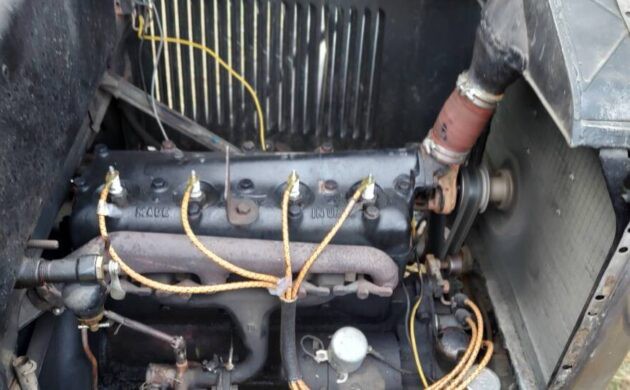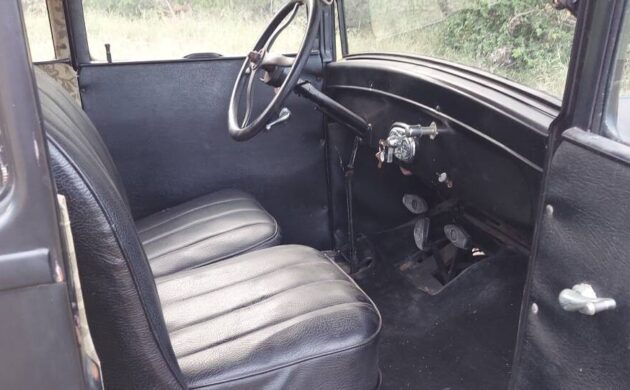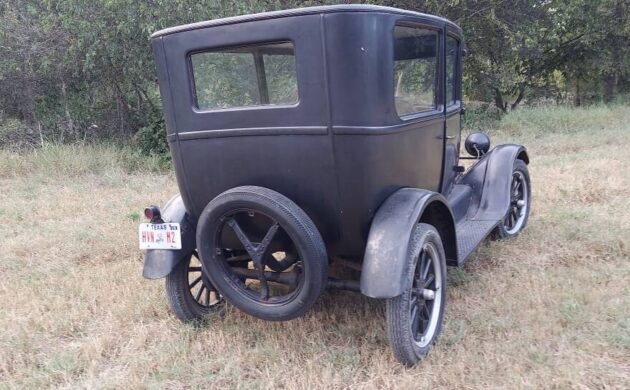Movie Star Car: 1926 Ford Model T Tudor
Here on craigslist is a 1926 Ford Model T Tudor (two-door, as opposed to Fordor, or four-door) that has apparently fraternized with George Clooney in the movie “O Brother, Where Art Thou?” Other than this tidbit and the seller’s claim that this T’s condition is “excellent”, the ad doesn’t say much. The seller is asking $10,500 or he will consider offers. That price isn’t too far above a “good” Model T, star power notwithstanding. The car is located in Georgetown, Ohio. We have T.J. to thank for this tip! This Model T is one of over 15 million built during the production run from 1908 through 1927. The first several years’ sales ramped rapidly with a crescendo in 1923 when over 2 million were sold. But by then, competition from Chevrolet began to devour market share. Henry Ford blamed his salespeople for not trying hard enough, then finally revamped the Model T for model year 1926. The revisions included a longer, higher hood; plated instead of painted radiator trim; a reconfigured headlight tie bar; and a relocated fuel filler. The car became heavier and more highly optioned but sales continued to slide.
The same 177 cu. in. four-cylinder motor carried every body style through 1927. In fact, Ford continued to make the Model T engine into 1941 to service the millions of Ts still on the road. The motor was capable of 20 bhp and 40 mph. By 1926 the car had an electric starter – a big plus since the hand crank was outright dangerous. This engine bay is fairly tidy but the seller neglects to mention its running condition. This is a good time to mention that driving a Model T is not like driving anything else. Three pedals control the transmission – and one of them is the brake, which works on the transmission rather than the wheels. The throttle lever is on the steering wheel.
This car’s interior is in fine shape. The rear seat area looks like Grandma’s parlor, but the new buyer can always redo the wallpaper! Thanks to the paucity of equipment provided by Henry with his early Model Ts, a thriving ecosystem of aftermarket suppliers grew up around Ford. Horns, speedometers, signal lights, mirrors, and more were available – much of it made by Stewart Warner. At least by 1926 a speedometer and odometer were standard.
Straight panels boost the appeal here, though I find the black-on-black color scheme uninspiring. Henry Ford’s declaration that customers could have any color so long as it was black came into play from 1914 through 1925. Before that and after that, the Model T was available in a small variety of colors. The first thing I would do is sand off this paint and try a new color! How about you?
Auctions Ending Soon
 2002 Subaru Impreza WRXBid Now15 hours$333
2002 Subaru Impreza WRXBid Now15 hours$333
 1975 Chevrolet Corvette ConvertibleBid Now16 hours$4,000
1975 Chevrolet Corvette ConvertibleBid Now16 hours$4,000
 1964 Ford F-100 Camper CustomBid Now17 hours$2,000
1964 Ford F-100 Camper CustomBid Now17 hours$2,000
 2006 Jeep Wrangler SportBid Now2 days$11,000
2006 Jeep Wrangler SportBid Now2 days$11,000
 1974 Datsun 260ZBid Now4 days$750
1974 Datsun 260ZBid Now4 days$750





Comments
Darn, not sure of what makes the author laugh, but I thought of the Simpsons episode of the same name where Homer designs a car. It was one of the funniest, yet saddest and apparently had nothing to do with the real movie, that I never saw. While the self starter is a big plus, the hank crank isn’t as dangerous as most may think. The motor has low compression, not like cranking a diesel, and takes a knack. Always pull UP on the crank, and a far more deterrent,I think, would be actually getting it moving. I believe this still had the original shifting thing with the pedals? A correction? I don’t think any pedal is the brake? The brake is the hand lever on the left, although, many, I heard, used the reverse pedal as a brake, wearing out the reverse band, anyone? I’ve shifted practically every transmission known to man, but never a Model T. How hard could it be? A HAND THROTTLE( buzzer sounds) what the heck is that? Retard the spark,,GRANDPA, HELP!!
Yeah, well, gramps is pushing daisies and a Model T, while I’m sure still a following, gets less and less interest as time marches on. Still, pretty hard to believe this started it all, the self starter, we take for granted today, was a marvelous invention, and opened up the world of driving to many, much like power steering of the 50s did. The Model T was the epitome of simplicity. Sadly, I doubt up and coming generations will even know how to start a Model T, just like I can’t figure out their stupid phones. It’s all relative, I suppose. Great write up and for the record, the “movie” schtick does nothing. There are outfits in Hollywood that rent cars for movies, in the past, cars on Dragnet showed up on Adam-12 miraculously, but just a Model T here folks.
HanD crank, it’s early,,for some.
Come on Howard phones aren’t that bad. My 92 year old Mom does better than my 68 year old sister. The technology that you hold in your hand is light years ahead of that T but the got it done. Some were later tractors and snow machines, they did it all. But alas your correct many people today don’t want to drive a car, maybe ride in one. Autonomous driving scares the crap out of me, lived long enough to know anything can fail.
Regarding hand cranking. It is possible to start a nice warm, tuned Model T by pulling up on the crank, but that gives you one piston worth of compression stroke travel to fire on. In the real world, (cold or fouled plugs) it is very difficult to start on one pull up. So you need to grasp the handle fully and go round and round until it fires. If you forget to retard the spark (you only forget once) it might misfire on the down push and send a pretty good thump through your arm. Although I was always cautions about the breaking your arm tale, I not heard of anyone in real life actually doing so. It is very difficult to start a recalcitrant Model T, especially for for women. My Mom had to have someone come out of the store to crank hers.
Electric start solved all of this and makes owning a Model T so much easier. While nostalgia is nice, cranking a Model T is something you don’t really want to be required to do. It can take all the fun out of the car before the drive even begins.
I read that some folks would dump the oil, warm it up, reinstall the oil (ha ha), and then crank the car.
Well, Howard, a Model T was an interesting car to drive to say the least. The hand brake applied the brakes in the rear wheels. It also put the transmission in Neutral. Your left pedal is Low-High; the center pedal is Reverse, and the right pedal is the foot brake. To get moving you give it some throttle, and tramped down on the left pedal while releasing the hand brake. All going well, the car would start moving. When you got going well, you eased back on the throttle, eased up on the pedal and made sure that the parking brake was all the way forward. With a distinct shudder it would shift into High.
To stop you stepped on the right pedal. To really stop, you pulled the hand brake. You could also stop the way Ralph Stein described in “Treasury of the Automobile.” “To stop you tramped on Everything; it didn’t matter which two pedals your feet hit.” Close quote.
I might add with a story from the Reynolds Museum. They have a ‘27 T Depot Hack which they use to shuttle visitors over to the aviation museum and back. They originally had a curb to pull up to in order to load and unload passengers but had to reroute to a parallel stop because too many drivers would “Step on the Clutch.”
Thanks, pal, now that I know, there’s a 0% chance I will ever need that info, but never know. I can hear it now, some emergency, “Can anyone here drive a Model T ?”( Airplane movies) Maybe not, still, had to start somewhere.
I speak jive!
Airplane II: “We’ve run out of coffee…”
Hard to drive? We could say the same thing of cars of our youth. My Pinto wagon had a four-speed transmission; an extra pedal down by the left foot…and – after I wearied of sticking, crude automatic-chokes – it sprouted a pull knob on the dash, with a big C on it.
You turned the key to start, but you had to HOLD that key for as long as it took. And don’t you DARE forget about that left pedal – unless you want to go through the garage wall.
I’ve never driven a T; but I’ve had to coach a couple of young drivers in the Shiftless era, into learning how to balance brake, clutch and throttle. Now, the new cars…just touch the key over, and it cranks as long as it takes, quits cranking when not needed, and starts and stops automatically at every light. To say nothing of Lane Sentry, or whatever it’s called, to keep you in your lane when you doze off on the Interstate.
I think I’d rather deal with a T’s planetary transmission. And hand throttles weren’t unusual, back when – in boats or on tractors. When speed is slow and traffic is light, I think they’d work fine.
About 20 years ago, our local Model T club had a “learn how to drive a Model T” event at a local, little-used shopping mall parking lot. It was near my house on a Saturday morning so I stopped by to give it a try.
Between using the three pedals, and adjusting the throttle and spark advance on the steering wheel, it was quite the challenge to get the hang of it – and I consider myself to be one of those people who can drive nearly anything. With a lot of practice, I imagine I could learn to do it proficiently, but it was not easy in the time I had to do it though.
I’m grateful for the opportunity to at least try it. I can’t imagine a typical driver in today’s cars ever managing something like it.
Regarding starting handles, don’t forget to keep yer thumb out of the way…
Wow! After reading these comments I wonder if fear is the reason some folks don’t buy an antique car. A T is very easy to drive. One of the reasons they were so popular when they were new. Easy to drive and easy to maintain and repair. I work on these almost every day in my small business. I would be happy to teach anyone to drive and maintain one or more! These cars be great fun to drive and give you a different perspective. If you want to learn, buy one, or have one fixed look me up at “Papa’s Vintage Garage”. Don’t let people that have never driven one or even seen one in some cases tell you all about something they no nothing about.
I’m willing to bet that at 46 I’m one of the younger people that look at this page and that’s only when I’m taking a dump. Probably a good thing the old know it alls that post on here don’t actually own a specialty vehicle and don’t go to the shows I do with my hot rods. I encourage young people know matter what they want to drive and am super happy when kids want to sit in my cars or get pics with it. I’ve driven a tall T and they aren’t that hard to get used to and are really fun to drive.
2100+/- miles away I wonder how it would do driving it home would want to wait until spring/summer but would make for a fun road trip staying off the main highways
hot in the summer, cold in the winter, top speed 40 miles an hour.
Well complicated is to each their own. To me comparing a Pinto to a Model T is ridiculous. Roads were made for horses and wagons when Model T’s were built. Cars were a new invention, trucks were quite useful for merchants and farmers. My Dad (born 1909) drove these things into the 20’s. He had lot’s of tales about him and his father making deliveries with their truck in and around Northeast Oklahoma and Southeast Kansas. By the time he married my mother in 1928 He was driving a new Oldsmobile. He could drive anything with an engine and wheels. By the time he passed away on January 4, 1978 he was driving a Datsun 510 and living the good life in Honolulu. I really miss my Dad, he taught me a lot about life. When I was 8 years old he taught me how to drive a stick shift car, a 1948 Dodge fluid drive. We repaired everything on his farm just north of Redding, California. Now I’m not long for this world, and I’m looking forward to seeing him in Heaven.
God Bless America
The strangeness of the controls, when you compare a Pinto to today’s electronic-everything auto-shift, touch-start car. As I tried to show, starting with what’s that third pedal. Oh, and that button down on the left toeboard!….
I’m saying the leap, 1972 to now, is as great as a leap from 1926 to our (old-timers’) eras.
It’s too early for you